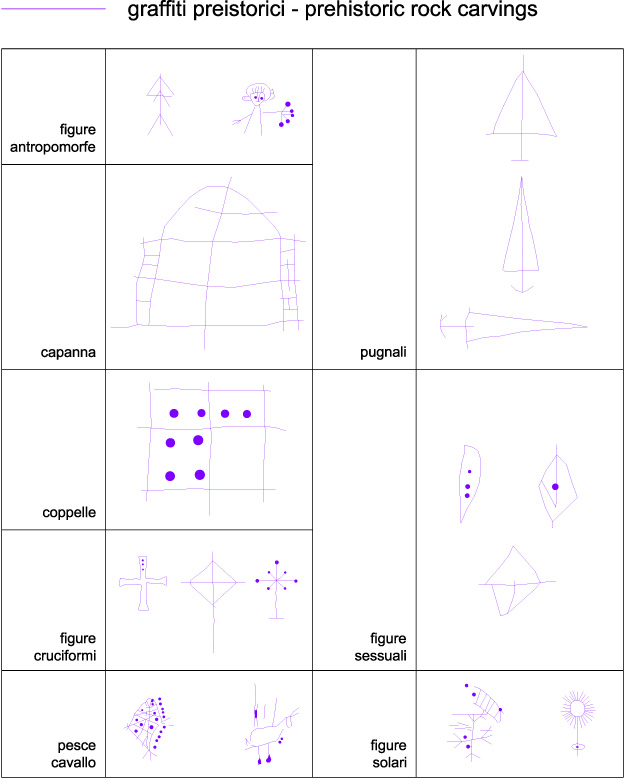|
|
File
Protohistoric rock carvings in the Assa valley – Roana
|
| Locality Tunkelbald – 36010 Roana (VI)
|
  |
|
Summary

The archaeological area displays some rock engravings dating back to the I millennium B.C. The engravings mainly represent anthropomorphic and theomorphic images as well as symbols of the sun.
History of research
The rock engravings were discovered in 1981, after an exceptional flood of the Assa stream removed the alluvial deposits from the shore and redefined the waterway in its current shape.
Urban and geographical context
On the western side of the plateau “Altopiano dei Sette Comuni” there are many valleys. The deepest one is the Assa valley, which starts at the Vezzena pass and which tortuously heads first to the south, then to the west where it flows into the Astico valley. At the bottom of the Assa valley, along the river shore and on a rock unit of “Ammonitico Rosso”, we can see the rock engravings, the object of this visit.
Chronology
X B.C. (end) and Medieval times |

 The drawings were made with the graffiti technique, that is by engraving the rock with stone or iron tools. The type of engraving can be thin, which is called stringy, or with a continuous V or U shaped furrow, which is called polissoir engraving. The repertory of images is broad and their chronological dating is complex. The drawings are rather symbolic than descriptive: there are many crosses, cup marks, crossbows and geometric shapes. Few are the animal drawings: it is possible to recognize a little horse and a fish. The chronological span is still uncertain. However, some of the drawings can be referred to the late Iron age (end of the I millennium B.C.): it is the case of shapes such as huts, topographic drawings, stairs and five-pointed stars, all symbols which appear in coeval rock art. The cup marks appear either individually or associated with other images in various arrangements, and they are still difficult to date. The late Middle Ages symbols prevail, such as crosses and crossbows. The few anthropomorphic drawings do not share stylistic affinities and might have been produced in rather recent times. The drawings were made with the graffiti technique, that is by engraving the rock with stone or iron tools. The type of engraving can be thin, which is called stringy, or with a continuous V or U shaped furrow, which is called polissoir engraving. The repertory of images is broad and their chronological dating is complex. The drawings are rather symbolic than descriptive: there are many crosses, cup marks, crossbows and geometric shapes. Few are the animal drawings: it is possible to recognize a little horse and a fish. The chronological span is still uncertain. However, some of the drawings can be referred to the late Iron age (end of the I millennium B.C.): it is the case of shapes such as huts, topographic drawings, stairs and five-pointed stars, all symbols which appear in coeval rock art. The cup marks appear either individually or associated with other images in various arrangements, and they are still difficult to date. The late Middle Ages symbols prevail, such as crosses and crossbows. The few anthropomorphic drawings do not share stylistic affinities and might have been produced in rather recent times.
|

Admission: Su prenotazione
Visitability: Esterno e Interno
Ticket: No
 School access School access
Upon reservation
Recommended tour time (minutes): 60
 Rest points Rest points
Picnic area
 Information boards Information boards
 Guided Tours Guided Tours
Guided tours by the society "Archeidos", tel. 0424 691100 / 0444 594317, www.archeidos.it, and by the archaeological group “Ass Taal”, tel. 0424 692282
 Educational activities Educational activities
Teaching activities by the society "Archeidos", tel. 0424 691100 / 0444 594317, www.archeidos.it, and by the archaeological group “Ass Taal”, tel. 0424 692282
 Educational workshops Educational workshops
Teaching room
 Library and documentation centre Library and documentation centre
| Leonardi P., Rigoni G., Allegranzi A. 1982, Le incisioni rupestri della Val d’Assa sull’Altipiano dei Sette Comuni (Vicenza, Italia), in Preistoria Alpina, 18, pp. 175-190. |
| Arcà A., Fossati A., Marchi E., Tognoni E. 2001, Le ultime ricerche della Cooperativa "Le Orme dell’Uomo" sull’arte rupestre delle Alpi, in Archeologia e arte rupestre. L’Europa, le Alpi, la Valcamonica, Atti del Secondo Convegno Internazionale di Archeologia Rupestre (Darfo Boario Terme, 2-5 ottobre 1997), Milano, pp. 143-146. |
| Bonetto J. 2009, Veneto (Archeologia delle Regioni d’Italia), Roma, pp. 470-471. |
|

